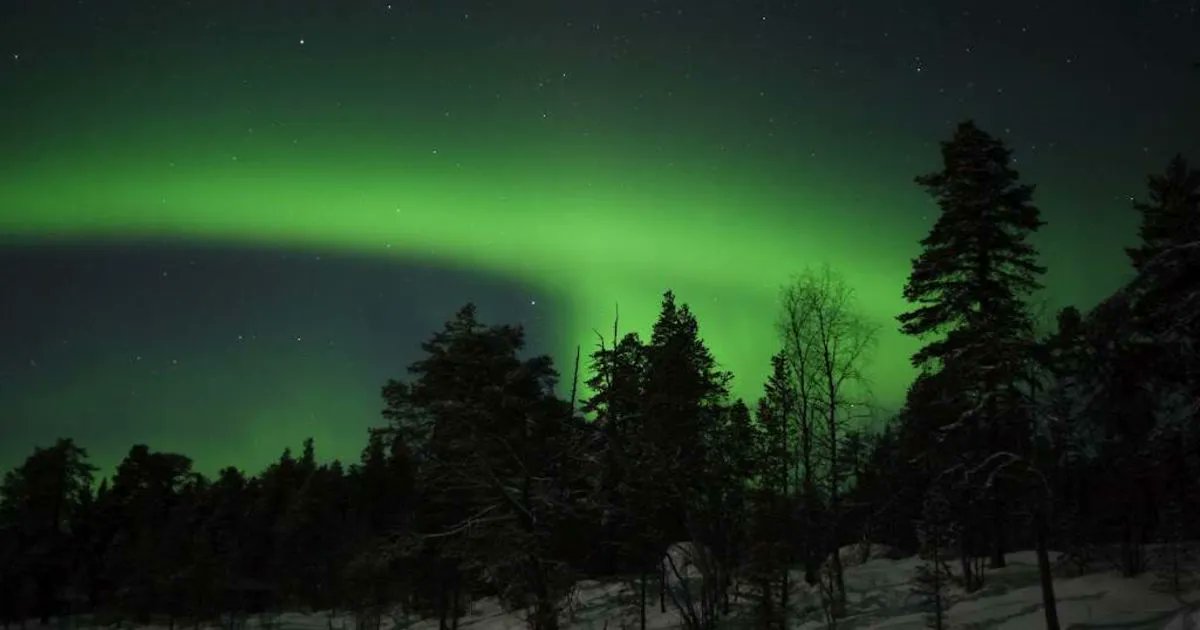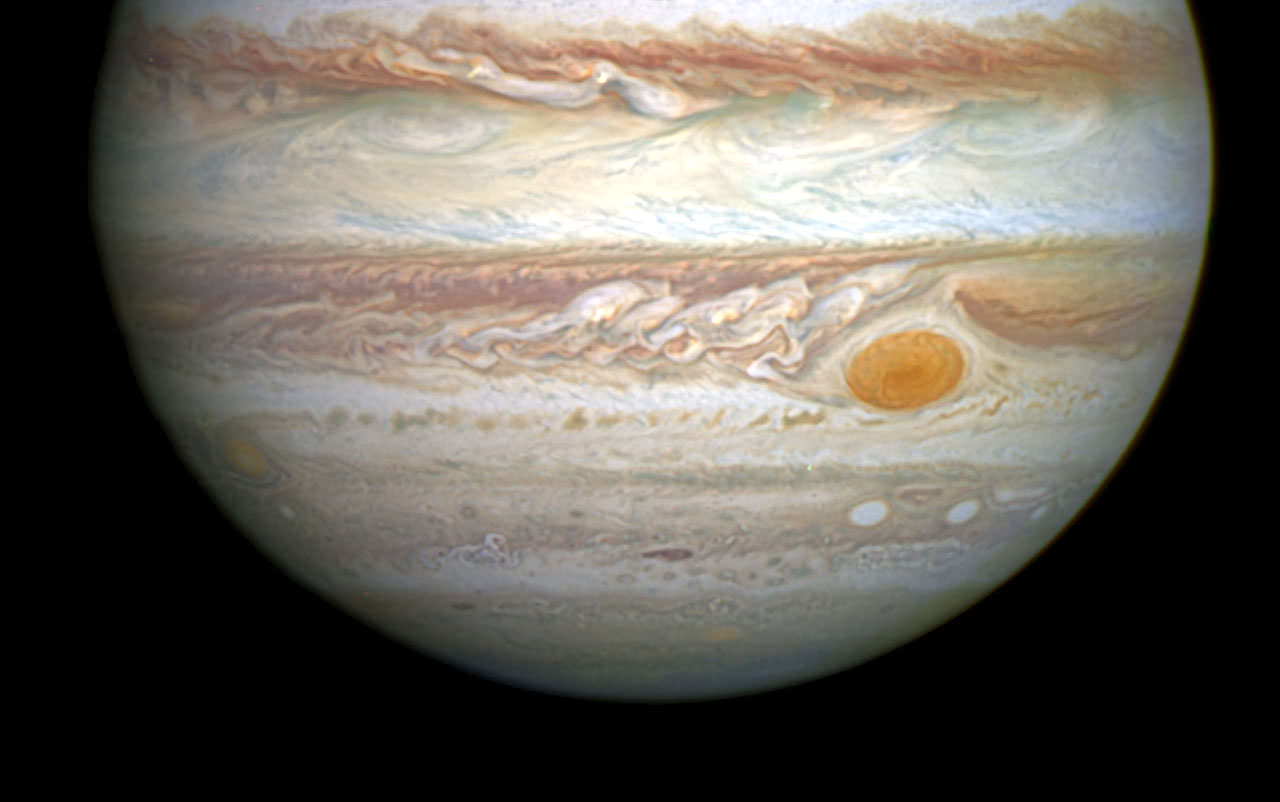Auroras are some of Earth’s most spectacular natural phenomena. Travelers come from far and wide to see the incredible Northern Lights and wonder at their beauty. Once thought to be magical in nature, most science fans understand that the lights are formed by the solar wind interacting with our magnetosphere. But did you know they also make sounds?
Continue reading “Even if you can’t see Auroras, You Can Sometimes Hear Them. Here’s What They Sound Like”Mars Has Auroras Too, We Just Can’t See Them
Our eyes can’t see them, but Martian auroras are there, and more commonplace than we once thought. The Martian auroras were first discovered in 2016 by NASA’s MAVEN spacecraft. Now some new results are expanding our knowledge of these unusual auroras.
Continue reading “Mars Has Auroras Too, We Just Can’t See Them”Did You Know that the Earth Loses Several Hundred Tons of Atmosphere to Space Every Day?
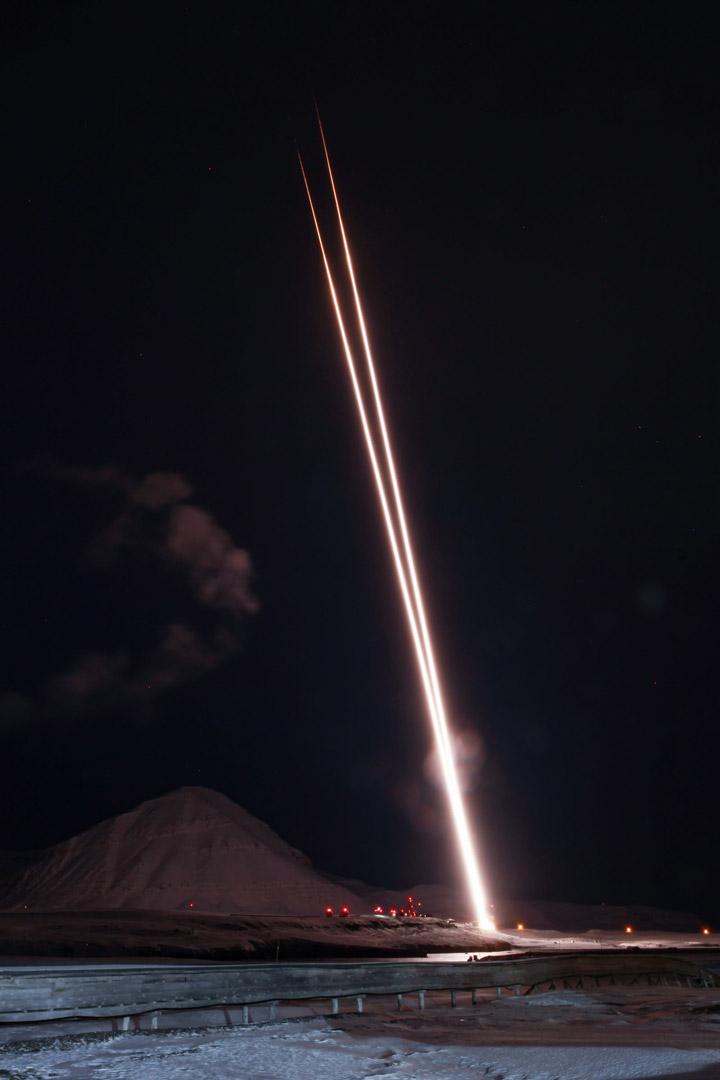
Scientists have known for some time that Earth’s atmosphere loses several hundred tons of oxygen each day. They understand how this oxygen loss happens on Earth’s night side, but they’re not sure how it happens on the day side. They do know one thing though; they happen during auroras.
According to a press release from NASA’s Earth Observatory, no two oxygen outflow events are exactly the same, which makes understanding them a challenge. They call the events ‘fountains of gas’ that escape the Earth during auroral activity, and the Earth Observatory has a mission dedicated to understanding them.
Continue reading “Did You Know that the Earth Loses Several Hundred Tons of Atmosphere to Space Every Day?”
Watch the Sun to Know When We’re Going to Have Killer Auroras
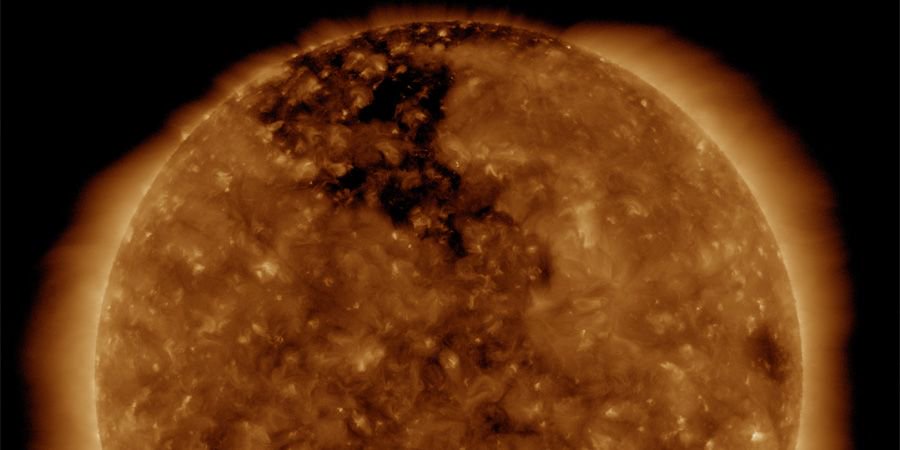
To the naked eye, the Sun puts out energy in a continual, steady state, unchanged through human history. (Don’t look at the sun with your naked eye!) But telescopes tuned to different parts of the electromagnetic spectrum reveal the Sun’s true nature: A shifting, dynamic ball of plasma with a turbulent life. And that dynamic, magnetic turbulence creates space weather.
Space weather is mostly invisible to us, but the part we can see is one of nature’s most stunning displays, the auroras. The aurora’s are triggered when energetic material from the Sun slams into the Earth’s magnetic field. The result is the shimmering, shifting bands of color seen at northern and southern latitudes, also known as the northern and southern lights.
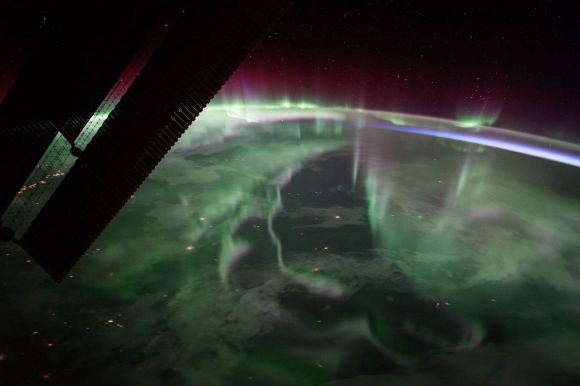
There are two things that can cause auroras, but both start with the Sun. The first involves solar flares. Highly-active regions on the Sun’s surface produce more solar flares, which are sudden, localized increase in the Sun’s brightness. Often, but not always, a solar flare is coupled with a coronal mass ejection (CME).
A coronal mass ejection is a discharge of matter and electromagnetic radiation into space. This magnetized plasma is mostly protons and electrons. The CME ejection often just disperses into space, but not always. If it’s aimed in the direction of the Earth, chances are we get increased auroral activity.
The second cause of auroras are coronal holes on the Sun’s surface. A coronal hole is a region on the surface of the Sun that is cooler and less dense than surrounding areas. Coronal holes are the source of fast-moving streams of material from the Sun.
Whether it’s from an active region on the Sun full of solar flares, or whether it’s from a coronal hole, the result is the same. When the discharge from the Sun strikes the charged particles in our own magnetosphere with enough force, both can be forced into our upper atmosphere. As they reach the atmosphere, they give up their energy. This causes constituents in our atmosphere to emit light. Anyone who has witnessed an aurora knows just how striking that light can be. The shifting and shimmering patterns of light are mesmerizing.
The auroras occur in a region called the auroral oval, which is biased towards the night side of the Earth. This oval is expanded by stronger solar emissions. So when we watch the surface of the Sun for increased activity, we can often predict brighter auroras which will be more visible in southern latitudes, due to the expansion of the auroral oval.

Something happening on the surface of the Sun in the last couple days could signal increased auroras on Earth, tonight and tomorrow (March 28th, 29th). A feature called a trans-equatorial coronal hole is facing Earth, which could mean that a strong solar wind is about to hit us. If it does, look north or south at night, depending on where your live, to see the auroras.
Of course, auroras are only one aspect of space weather. They’re like rainbows, because they’re very pretty, and they’re harmless. But space weather can be much more powerful, and can produce much greater effects than mere auroras. That’s why there’s a growing effort to be able to predict space weather by watching the Sun.
A powerful enough solar storm can produce a CME strong enough to damage things like power systems, navigation systems, communications systems, and satellites. The Carrington Event in 1859 was one such event. It produced one of the largest solar storms on record.
That storm occurred on September 1st and 2nd, 1859. It was preceded by an increase in sun spots, and the flare that accompanied the CME was observed by astronomers. The auroras caused by this storm were seen as far south as the Caribbean.
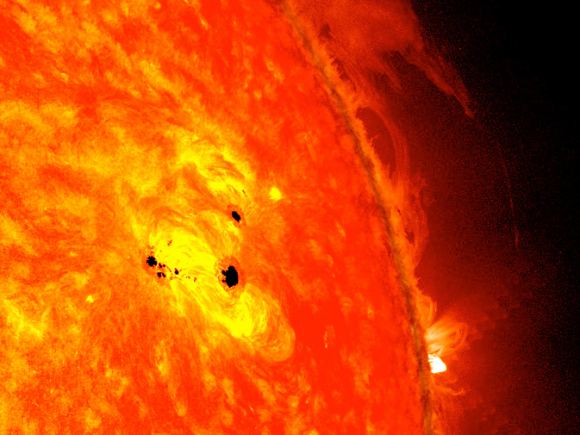
The same storm today, in our modern technological world, would wreak havoc. In 2012, we almost found out exactly how damaging a storm of that magnitude could be. A pair of CMEs as powerful as the Carrington Event came barreling towards Earth, but narrowly missed us.
We’ve learned a lot about the Sun and solar storms since 1859. We now know that the Sun’s activity is cyclical. Every 11 years, the Sun goes through its cycle, from solar maximum to solar minimum. The maximum and minimum correspond to periods of maximum sunspot activity and minimum sunspot activity. The 11 year cycle goes from minimum to minimum. When the Sun’s activity is at its minimum in the cycle, most CMEs come from coronal holes.
NASA’s Solar Dynamics Observatory (SDO), and the combined ESA/NASA Solar and Heliospheric Observatory (SOHO) are space observatories tasked with studying the Sun. The SDO focuses on the Sun and its magnetic field, and how changes influence life on Earth and our technological systems. SOHO studies the structure and behavior of the solar interior, and also how the solar wind is produced.
Several different websites allow anyone to check in on the behavior of the Sun, and to see what space weather might be coming our way. The NOAA’s Space Weather Prediction Center has an array of data and visualizations to help understand what’s going on with the Sun. Scroll down to the Aurora forecast to watch a visualization of expected auroral activity.
NASA’s Space Weather site contains all kinds of news about NASA missions and discoveries around space weather. SpaceWeatherLive.com is a volunteer run site that provides real-time info on space weather. You can even sign up to receive alerts for upcoming auroras and other solar activity.
Big Solar Storm Coming Our Way, Now’s Your Chance to See Auroras

If you’re still riding that high from seeing the recent total solar eclipse and you want to keep the party going, now’s your chance to see another of the night sky’s wonders: an aurora. That said, a totally full Moon is going to try and wreck the party.
NASA announced that two powerful flares were just emitted on the surface of the Sun, casting coronal mass ejections in our direction. Over the course of the next couple of days, this should generate aurora activity in the sky outside the regular viewing areas. In other words, if you normally don’t see the Northern Lights where you live, you might want to spend a few hours outside tonight and tomorrow. Look up, you might see something.
This morning, the Sun released the most powerful solar flare recorded since 2008. Here's what our satellite saw: https://t.co/mk2540AdtV pic.twitter.com/7hVektV682
— NASA Sun & Space (@NASASun) September 6, 2017
The first flare, an X2.2 event, peaked on September 6 at 5:10 am EDT and the second X9.3 flare went off at 8:02 am. Both of which came from the sunspot group AR 2673. If you’ve still got those eclipse glasses, take a look at the Sun, and you should be able to see the sunspot group right now. There are two groups of sunspots close to one another, AR 2673 and AR 2674. This follows up the X4 flare emitted on September 4th.
Solar astronomers measure flares using a similar scale to other natural events, with a series of designations. The smallest are A-class, then B, C, M and finally X. Each level within the rating accounts for double the strength; it’s exponential. So, and X2 is twice as powerful as an X1, etc. The most powerful flare ever recorded was an X28 in 2003, so today’s flare is still comparatively weak to that monster.

But, measuring in at X9.3, today’s flare is the strongest in almost a decade. The last one this strong was back in 2008. And NOAA is predicting that this flare could cause radio blackouts across the sun-facing side of the Earth. If you’re out at sea and depending on your radio transmissions, don’t be surprised if you’re getting a lot of static today.
How do you stand the best chance of seeing auroras? My favorite tool comes from NOAA’s 3-day aurora forecast. It shows you a 3-day predictive simulation for what the solar storm should do as it buffets the Earth’s magnetosphere. You can run the simulation backwards and forwards, and you’re looking glowing green areas to come across your part of the world.
But even if it doesn’t look like you’re going to see the auroras, I still think it’s worth trying. Even if you don’t get an aurora directly overhead, you can sometimes see it on the horizon, and it can be surprisingly beautiful.
Here’s my timelapse video of auroras on the horizon.
The big problem, of course, is the Moon. Tonight is also a full Moon, which means that awful glowing ball is going to rise just after sunset and blaze across the sky all night. You’re going to have a rough time seeing all but the brightest auroras. But I still think it’s worth trying.
If you want to maximize your chances of seeing an aurora, check out the Space Weather site on a regular basis. There are also services that’ll send you a text message when there’s a powerful aurora going on in your area (just Google “aurora alert text messages”. And of course, there are handy apps that’ll make your phone beep boop when there are auroras overhead. I use an app called Aurora Alert.
We’ve had three powerful flares in the last couple of days, which means that the Sun is feeling a little frisky. There could be more, and they could happen after the full Moon is over, and we’ve got some alone time with the dark sky. So stay on top of the current space weather, spend time outside, and keep your eyes on the sky. You might get a shot at seeing an aurora.
And once you’ve seen one, you’ll be hooked.
Source: NASA News Release
What is the Weather like on Jupiter?
Welcome to a new series here at Universe Today! In this segment, we will be taking a look at the weather on other planets. First up, we take a look at the “King of Planets” – Jupiter!
One of the most obvious facts about the gas giant Jupiter is its immense size. With a mean radius of 69,911 ± 6 km (43441 mi) and a mass of 1.8986 × 1027 kg, Jupiter is almost 11 times the size of Earth, and just under 318 times Earth’s massive. But this “go big or go home” attitude extends far beyond the planet’s size.
When it comes to weather patterns, Jupiter is also an exercise in extremes. The planet experiences storms that can grow to thousands of kilometers in diameter in the space of a few hours. The planet also experiences windstorms, lightning, and auroras in some areas. In fact, the weather on Jupiter is so extreme that it can be seen from space!
Jupiter’s Atmosphere:
Jupiter is composed primarily of gaseous and liquid matter. It is the largest of the gas giants, and like them, is divided between a gaseous outer atmosphere and an interior that is made up of denser materials. It’s upper atmosphere is composed of about 88–92% hydrogen and 8–12% helium by percent volume of gas molecules, and approx. 75% hydrogen and 24% helium by mass, with the remaining one percent consisting of other elements.
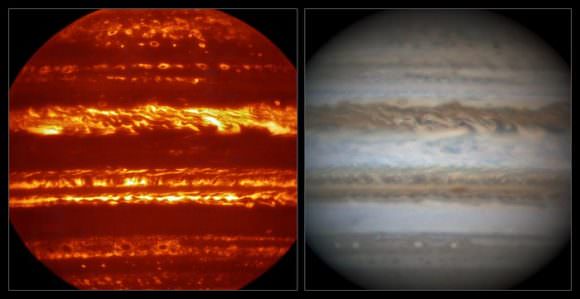
The atmosphere contains trace amounts of methane, water vapor, ammonia, and silicon-based compounds as well as trace amounts of benzene and other hydrocarbons. There are also traces of carbon, ethane, hydrogen sulfide, neon, oxygen, phosphine, and sulfur. Crystals of frozen ammonia have also been observed in the outermost layer of the atmosphere.
Jupiter is perpetually covered with clouds that are composed of these ammonia crystals, and possibly ammonium hydrosulfide. These clouds are located in the tropopause and are arranged into bands of different latitudes, known as “tropical regions”. The cloud layer is only about 50 km (31 mi) deep, and consists of at least two decks of clouds: a thick lower deck and a thin clearer region.
These clouds are also what gives the planet is banded appearance, with clouds of yellow, brown and white circling the surface rapidly. These bands are produced by air flowing in different directions at various latitudes. Lighter-hued areas where the atmosphere rises are called zones. Darker regions where air falls are called belts. When these opposing flows interact, storms and turbulence appear (aka. “zonal jets”).
The Great Red Spot:
As noted already, Jupiter experiences violent storms, which often take the form of zonal jets. In these weather fronts, wind speeds of 100 m/s (360 km/h) are common. But wind storms on the mighty planet can reach as high as 620 kph (385 mph). These storms can form within hours and become thousands of kilometers in diameter overnight.

One storm, the Great Red Spot, has been raging since at least the late 1600s – when Italian astronomer Giovanni Cassini made the first recorded observation of it. The storm has been shrinking and expanding throughout its history; but in 2012, it was suggested that the Giant Red Spot might eventually disappear.
This storm is one of the best known features in the Solar System. It is located 22° south of the equator and reaching sizes of up to 40,000 km across, it is larger in diameter than Earth. The storm rotates in a counter-clockwise motion, making it an anti-cyclonic storm.
It rotates differently than the rest of the atmosphere: sometimes faster and sometimes slower. During its recorded history it has traveled several times around the planet relative to any fixed position below it.
Meteorological Phenomena:
Jupiter also experience weather phenomena that are similar to those of Earth. These lightning storms, which have been detected in Jupiter’s atmosphere. Scientists believe that these may be due to a thin layer of water clouds underlying the ammonia layer.

The presence of this water layer (and it’s polarity) would create the charge separation needed for lightning to occur. Observations of these electrical discharges indicate that they can be up to a thousand times as powerful as those observed here on the Earth.
Like Earth, Jupiter also experiences auroras near its northern and southern poles. But on Jupiter, the auroral activity is much more intense and rarely ever stops. The intense radiation, Jupiter’s powerful magnetic field, and the abundance of material from Io’s volcanoes that react with Jupiter’s ionosphere, create a light show that is truly spectacular.
What it comes down to is that Jupiter experiences weather that is similar to what we experience here on Earth. This includes wind storms, lightning, and auroras in both the northern and southern polar regions. The only difference is, in Jupiter’s case, the size and scale of the weather is much, much larger!
On Jupiter, as with everything else on the “King of Planets”, the weather is the result of titanic forces that produce some seriously powerful results. If any of these were to happen here on Earth, the results would be disasterous!
We have written many interesting articles about Jupiter here at Universe Today. Here’s Ten Interesting Facts About Jupiter, How Long Does it take to get to Jupiter?, How Much Bigger is Jupiter than Earth?, How Strong is Jupiter’s Gravity?, and Jupiter Compared to Earth.
For more information, check out NASA’s Solar System Exploration – Jupiter, and the facts about Jupiter from Space Facts.
Astronomy Cast also has episodes dedicated to Jupiter – Episode 56: Jupiter, and Episode 57: Jupiter’s Moons.
Sources:
Stunning Auroras From the Space Station in Ultra HD – Videos
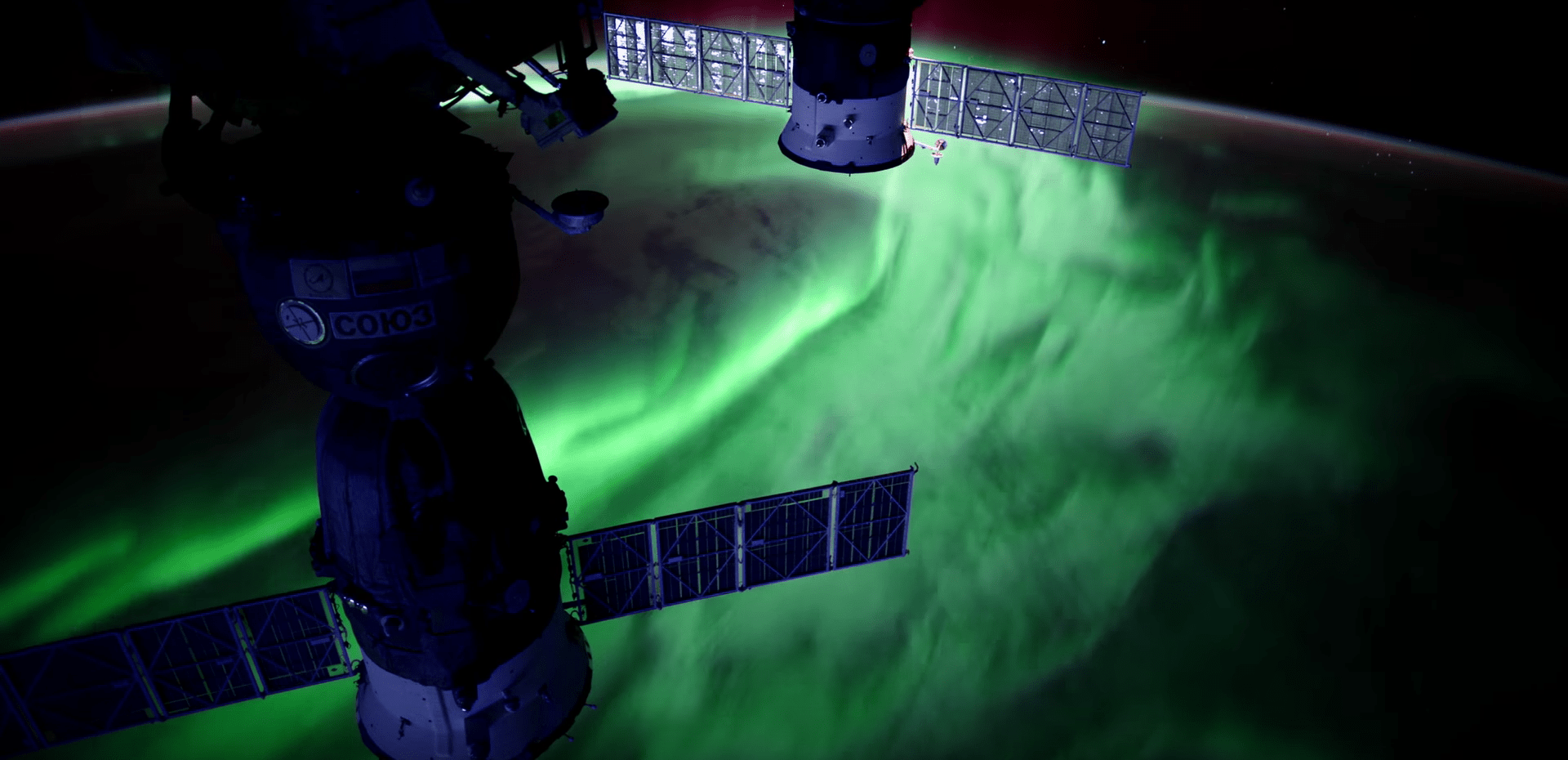

Stunning high definition views of Earth’s auroras and dancing lights as seen from space like never before have just been released by NASA in the form of ultra-high definition videos (4K) captured from the International Space Station (ISS).
Whether seen from the Earth or space, auroras are endlessly fascinating and appreciated by everyone young and old and from all walks of life.
The spectacular video compilation, shown below, was created from time-lapses shot from ultra-high definition cameras mounted at several locations on the ISS.
It includes HD view of both the Aurora Borealis and Aurora Australis phenomena seen over the northern and southern hemispheres.
The video begins with an incredible time lapse sequence of an astronaut cranking open the covers off the domed cupola – everyone’s favorite locale. Along the way it also shows views taken from inside the cupola.
The cupola also houses the robotics works station for capturing visiting vehicles like the recently arrived unmanned SpaceX Dragon and Orbital ATK Cygnus cargo freighters carrying science experiments and crew supplies.
The video was produced by Harmonic exclusively for NASA TV UHD;
Video caption: Ultra-high definition (4K) time-lapses of both the Aurora Borealis and Aurora Australis phenomena shot from the International Space Station (ISS). Credit: NASA
The video segue ways into multi hued auroral views including Russian Soyuz and Progress capsules, the stations spinning solar panels, truss and robotic arm, flying over Europe, North America, Africa, the Middle East, star fields, the setting sun and moon, and much more.
Auroral phenomena occur when electrically charged electrons and protons in the Earth’s magnetic field collide with neutral atoms in the upper atmosphere.
“The dancing lights of the aurora provide a spectacular show for those on the ground, but also capture the imaginations of scientists who study the aurora and the complex processes that create them,” as described by NASA.
Here’s another musical version to enjoy:
The ISS orbits some 250 miles (400 kilometers) overhead with a multinational crew of six astronauts and cosmonauts living and working aboard.
The current Expedition 47 crew is comprised of Jeff Williams and Tim Kopra of NASA, Tim Peake of ESA (European Space Agency) and cosmonauts Yuri Malenchenko, Alexey Ovchinin and Oleg Skripochka of Roscosmos.
Some of the imagery was shot by recent prior space station crew members.
Here is a recent aurora image taken by flight engineer Tim Peake of ESA as the ISS passed through on Feb. 23, 2016.
“The @Space_Station just passed straight through a thick green fog of #aurora…eerie but very beautiful,” Peake wrote on social media.
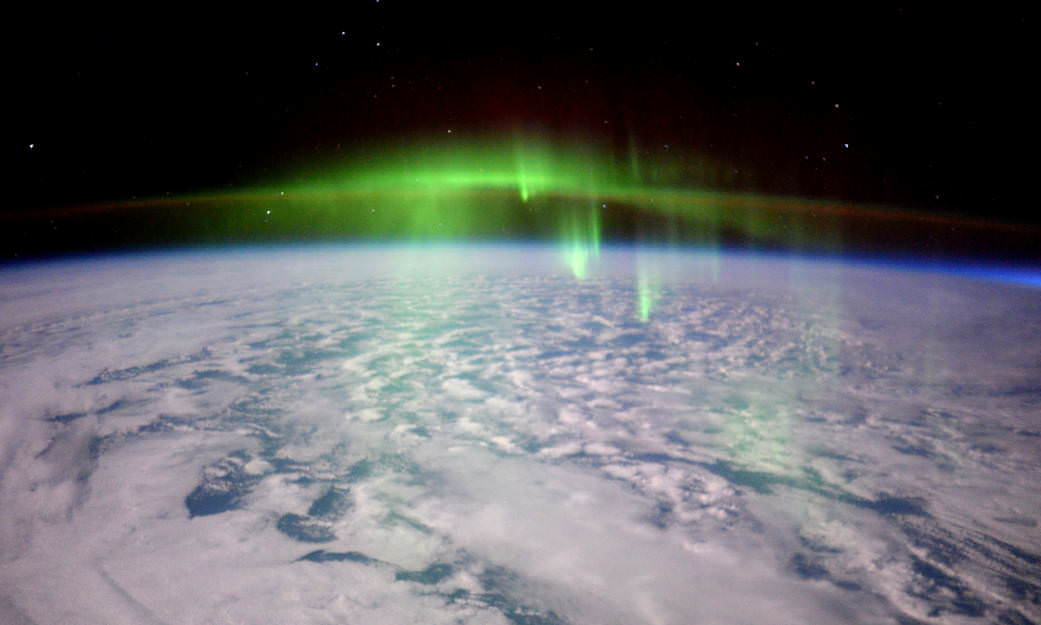
A new room was just added to the ISS last weekend when the BEAM experimental expandable habitat was attached to a port on the Tranquility module using the robotic arm.
BEAM was carried to the ISS inside the unpressurized trunk section of the recently arrived SpaceX Dragon cargo ship.
Stay tuned here for Ken’s continuing Earth and planetary science and human spaceflight news.
What Glows Green In Space?
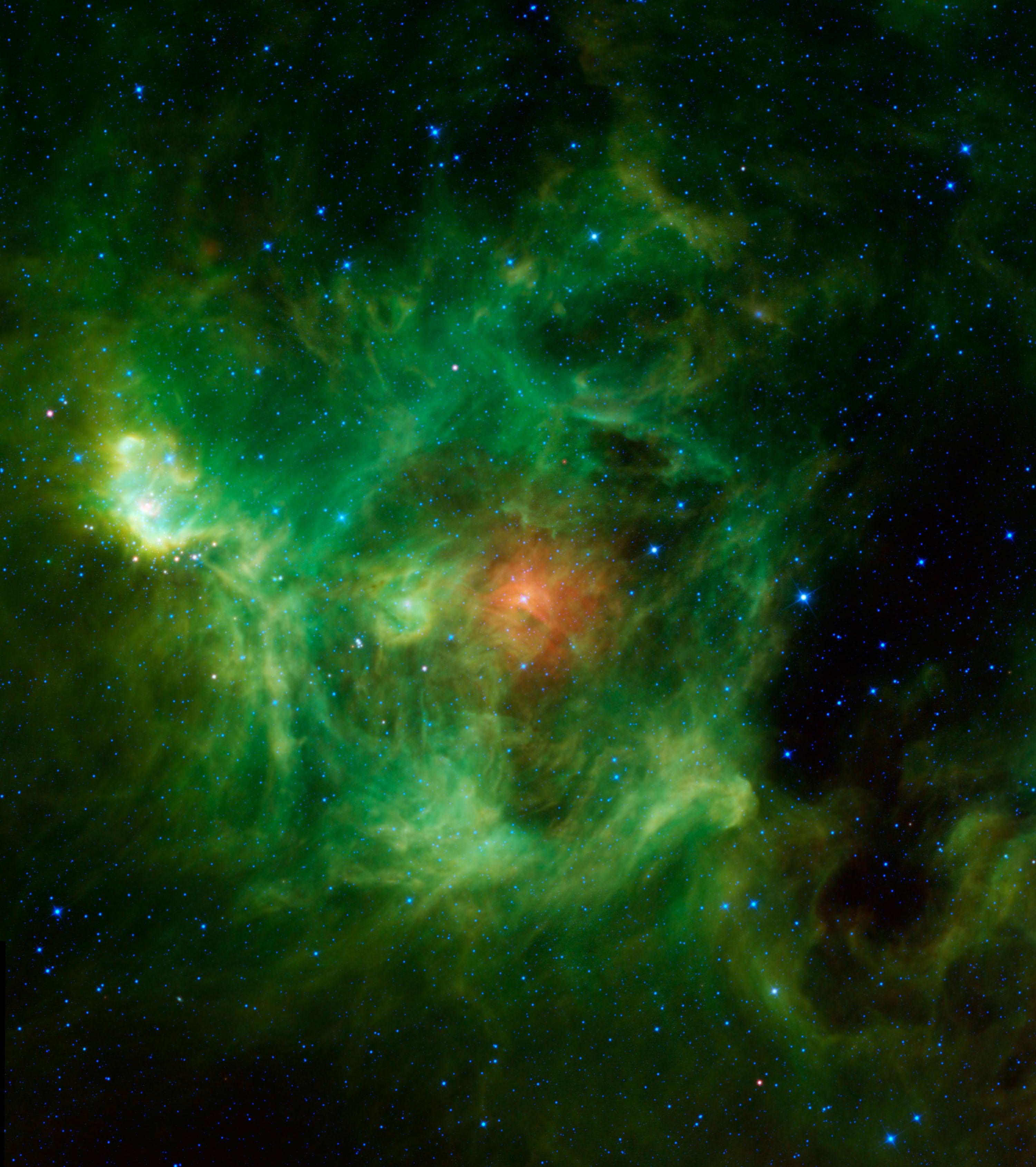
While a quest for green beer in space would be difficult, we’re happy to report there are other ways you can celebrate Saint Patrick’s Day while looking at the night sky. Just check out the nebulae and aurorae in these pictures!
A word of caution, these pictures are taken by cameras that expose light for a very long time, sometimes using different filters, to bring out the colors. A nebula, for example, seen with our own eyes does not look quite as stunning.
The picture above shows the Wreath Nebula, which apparently is filled with warm dust bits that are about the same composition as smog.
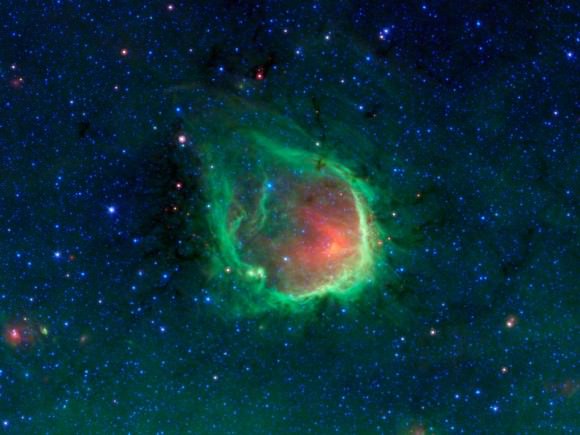
Here’s a picture of a “Green Ring” Nebula; the NASA press release is worth a read for the hilarious Green Lantern references. But besides the science fiction, there is some neat science in action here: “The green color represents infrared light coming from tiny dust grains called polycyclic aromatic hydrocarbons,” NASA writes. “These small grains have been destroyed inside the bubble. The red color inside the ring shows slightly larger, hotter dust grains, heated by the massive stars.”
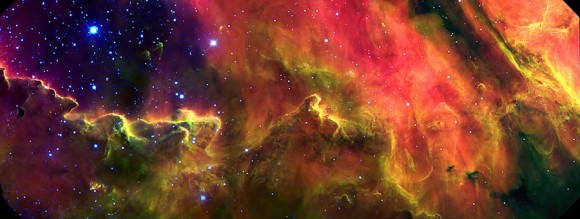
You can even see hints of green in the Lagoon Nebula picture above. Using a filter that picks up green (sulfur) emission, the astronomers ferreted out a bit of emerald.
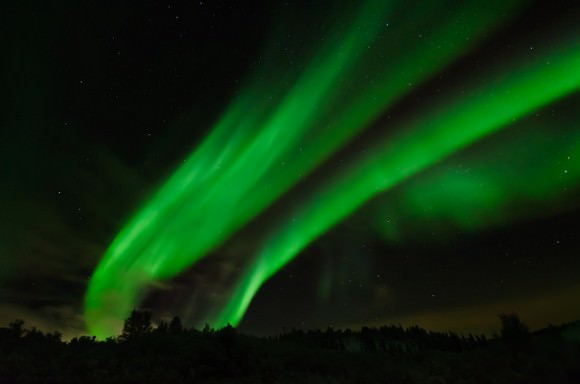
If you live far enough north or south, you occasionally get to see aurorae dancing across the sky. These events, sometimes known as the Northern Lights or Southern Lights, occur due to interactions between the sun’s particles and the Earth’s upper atmosphere. We had some green stunners in October 2012 after a solar flare pushed a bunch of these particles in Earth’s direction. Most of the light you see in auroras comes from oxygen atoms being “excited” from the interaction with the sun’s particles; green occurs at higher altitudes, and red at lower ones.
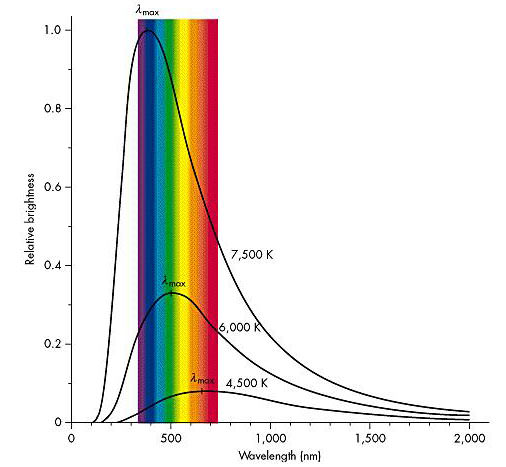
One object that can’t glow green in space, however, is a star. Stellar colors depend on the surface of the star. Blue stars, the hottest ones, are at about 12,000 Kelvin and red stars, the coolest ones, are less than 3,500 Kelvin. (The sun is about in the middle, at 6,800 Kelvin, as it emits white light.)
As Universe Today publisher Fraser Cain pointed out in a past post, the only way a green star could be possible is if the light curve peaks at green. That doesn’t work, however: “If you make the star hotter, it just gets bluer,” he wrote. “And if you make a star cooler, it just becomes orange and then redder. There’s no way to have a light curve that makes a star look green.” Check out more details here.

